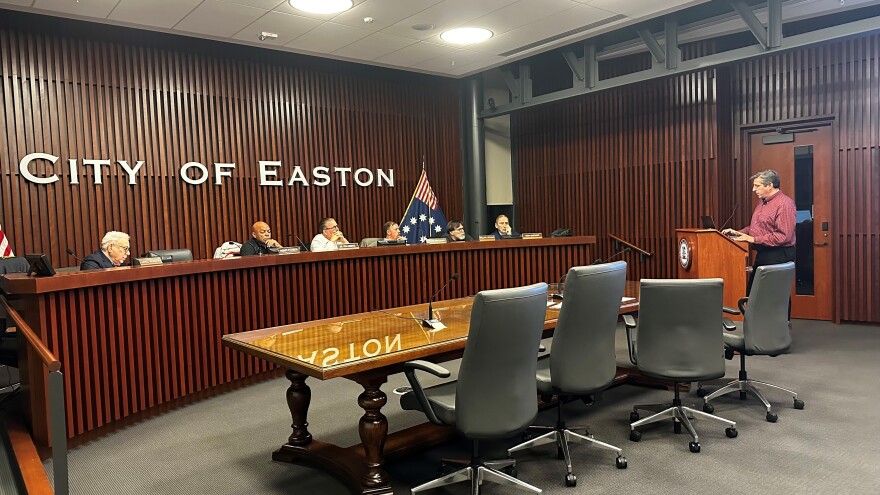EASTON, Pa. — Easton Planning Commission got an update of its comprehensive plan Wednesday, with administrators and commissioners agreeing that the city has made substantial progress on the list.
Planning Administrator Carl Manges presented the update, showcasing accomplishments since the 2017 plan and detailing some areas of interest as the city aims to grow to a population of 35,000 by 2040.
And while those accomplishments — including increased development of housing, public spaces, and sustainability initiatives — have certainly seen some victories, Manges and the planning commission agreed that the city will still face some substantial obstacles as they reach that population goal while maintaining a quality standard of living for residents.
Transform, Unify, and Thrive
“In our comprehensive plan, we have three separate goals: transform, unify, and thrive. And with each of those categories, they're both for the city, for the future, to be met, ideas that have been proposed, to see what we could do,” Manges said.
Within the realm of “transform,” the plan lists goals to establish an area around Centre Square as the city’s premiere business district, connect and develop Easton’s River Corridors as an integral part of the city, manage and reduce vacancy, underutilization, and blight throughout the city, and discourage irresponsible development and renovation, and prevent the deterioration of historic buildings.
The “unify” section seeks to re-envision public right of ways for multimodal travel and sustainable infrastructure, adapt and reuse critical sites at the seam of neighborhoods, integrate the Delaware and Lehigh Rivers and Bushkill Creek with upland communities through a connected system of pedestrian, bike, and open space networks, improve access to create new parks and open spaces, and manage parking and promote sustainable transportation.
Within the “thrive” section, the city aims to attract new business through a ‘business ready’ environment, promote strong and well-balanced neighborhood centers, connect residents with employment and workforce training centers and increase resident earning capacity, diversify and strengthen economic activities, entrepreneurship opportunities and tourist attractions, promote closer regional ties, and strengthen emergency responses and service throughout the city.
According to Manges, many of the specific goals detailed in the Thrive portion of the plan are in progress or already complete.
A redesign of Centre Square and the prioritized development of the Black Diamond site have already been finished, Manges said.
The retrofitting of vacant office spaces in the downtown district — including the Hearst Publication office — and revamping the gateways to the city (signs, landscaping, and lighting) are currently ongoing.
A master plan for the river corridors and an evaluation of the feasibility of a walking trail on the historic trestle bridge are in process.
A few elements still need to be tackled, including the installation of highway signs on Route 22 and Route 611, the design and installation of consistent signage for the downtown business district, and the implementation of a neighborhood revitalization plan.
Under the Unity heading, the prioritized streetscape design for Butler, Ferry, Lehigh, Wood, Washington, Cattell, and Northampton streets is underway, with some progress seen on Ferry, Wood, Cattell, and Northampton.
Other areas of success include the Black Diamond site, which has been developed with affordable housing and commercial prospects.
A secondary gateway planned at Wood Avenue and Northampton Street, the development of underutilized lots on South 3rd Street, the creation of a bike and pedestrian-friendly connection to the D&L Trail, and the exploration of pedestrian connections between Nevin Park and the Karl Stirner Arts Trail are in progress.
Other goals, like the reintroduction of a pedestrian bridge over the Lehigh River to connect the South Side with the West Ward, as well as an exploration of the use of county parking lots for passive recreation, may have to wait before the city can dive in.
Recommendations for the Thrive subheading will take a bit more time.
A plan to expand free public Wi-Fi beyond Centre Square and further develop high-speed internet infrastructure are being discussed with Intrepid Fiber Networks, and a mission to develop new lodging facilities in the downtown district has seen some progress with a new hotel on North 3rd Street, in addition to plans for the hotel in Centre Square being cleared.
Loftier goals for the future include developing the South Side Neighborhood Center, developing Butler Street into a secondary commercial corridor for the city, and attracting light manufacturing and small industries and enhancing the river corridors with appropriate uses are still in the cards.
Sustainability
Under sustainability goals, Manges detailed the city has performed a greenhouse gas inventory and adopted a Climate Action Plan in 2021, creating a ten-year agreement with the Nurture Nature Center to pursue these goals.
Overall, the city was certified Platinum by the PA Municipal League for Sustainability.
Switchovers to electric and hybrid vehicles, including a few in the police department, have also helped.
Other highlights include a building energy performance study, a solar study, and an EV charging study for City Hall have been completed, and several improvements to the location’s HVAC system have helped curtail energy use.
In 2025, Manges said, the city plans to hire a dedicated Sustainability Coordinator.
Housing developments, gateways, and parking
Since 2017, Manges said, the city has approved 1,117 new residential units, ranging from small-scale projects to large endeavors like the 273 units at The Confluence, another 280 at The Marquis, and 55 spots at the Mill at Easton.
According to Manges, these figures are on target for the city to hit a population of 35,000 by 2040.
“ They had the vision, and the public also [had a vision] – that was the main thing, is that they gave us ideas to put in the comprehensive plan, and it's come to fruition."Carl Manges
Other points of progress included the North 13th Street and U.S. 22 Interchange and gateway, with the interchange plans adding lane to westbound Wood Avenue, the elimination of a left-hand turn from the eastbound exit ramp, the replacement of poles, masts and signals, the addition of new concrete islands with ADA ramps, and new paving and line striping, coming in at a price of around $4.5 million.
As for parking, the 3rd Street Garage currently has 372 permits across numerous businesses and residences, while the 4th Street Garage lists 172 out of 491 spaces rented.
Planning Commissioner Hubert Etchison expressed some concern for parking issues even with the availability of spaces at the 4th Street Garage, especially in light of upcoming developments.
“I just don't want us to get a, for lack of a better term, false sense of security about the availability of the 4th Street Garage. But we know there's stuff coming online, and we're also, I won't say ignoring, but not taking into account the daily needs of people,” Etchison said.
Solicitor Joel Scheer stated that the city had agreed with The Marquis that the apartment complex would lease 200 spots for the 4th Street Garage, intended to clear some space at the 3rd Street Garage for public use.
While two members of the city’s Environmental Advisory Council, including Nick Gorski and Robert MacDonald, raised some concerns over building height limitations in the plan, the pair disagreed on how to address the matter.
Gorsksi suggested setting a flat rate of 55-foot building heights, while MacDonald suggested removing limits for residential buildings, provided developers handle the increased parking demand themselves to help assist growth.
Despite a few obstacles left on the table and the prospect of a new comprehensive plan coming in 2027 or sooner — base-level work has already commenced for this new version — Manges said he felt the city and his office saw substantial success with their goals over the past few years.
“I'm very happy with it, because a lot of the projects and goals that were put into the comprehensive plan back when we started, and the process by the consultant that we hired, Urban Matrix, they had this vision. They had the vision, and the public also [had a vision] — that was the main thing, is that they gave us ideas to put in the comprehensive plan, and it's come to fruition. So we're pretty happy about that,” Manges said.


